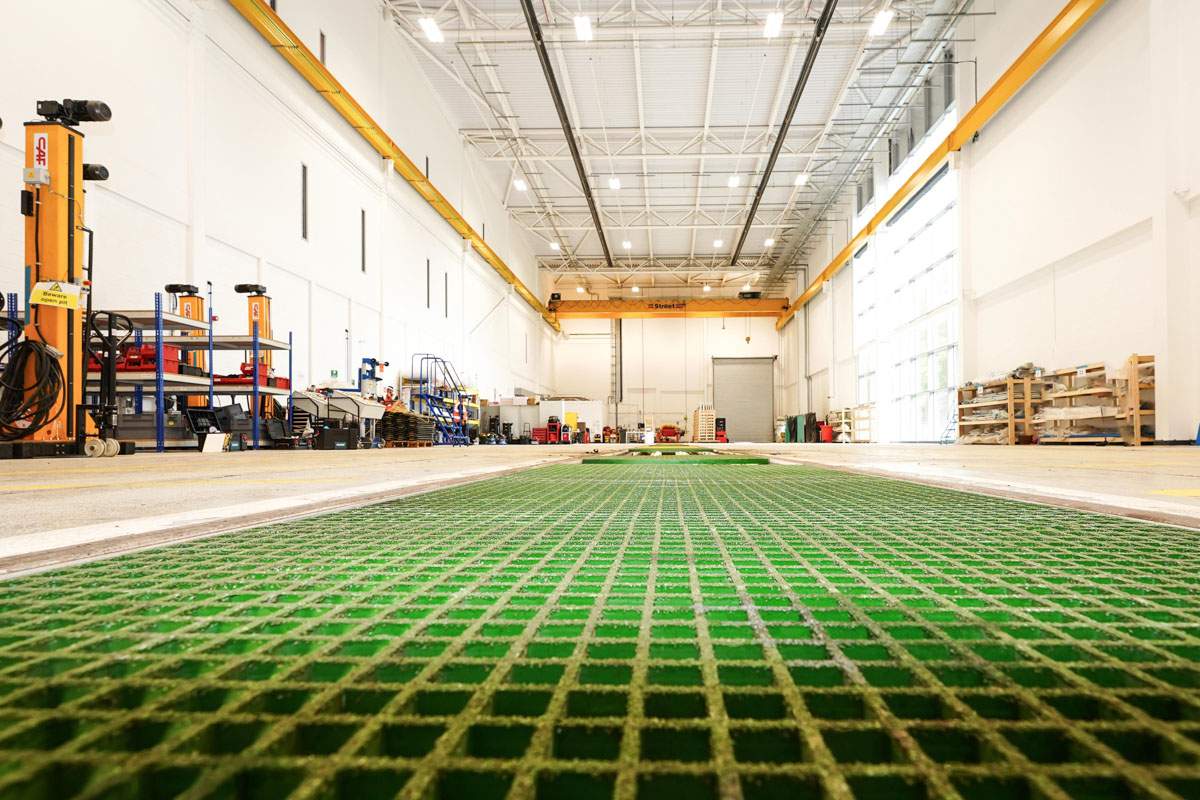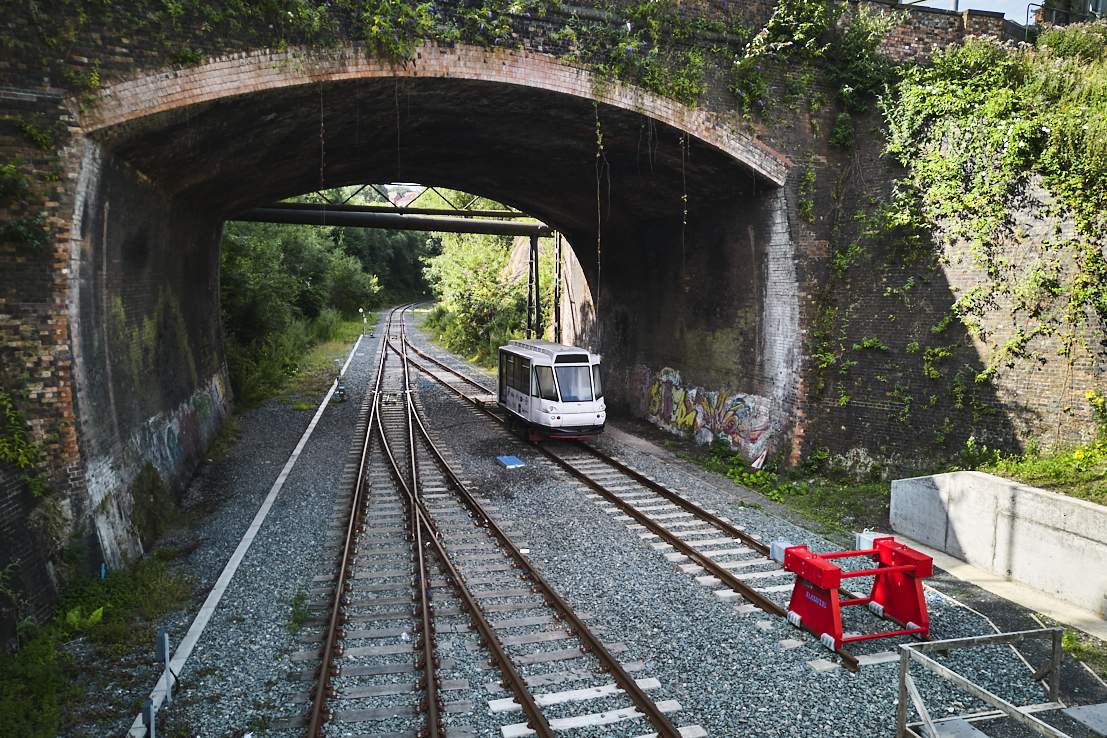This week the Very Light Rail National Innovation Centre (VLRNIC) opened its doors for the first in a series of monthly facility tours. ‘Behind the Scenes at BCIMO’ offers an insight into a unique, world-class centre for rail innovation in Dudley in the heart of the Black Country, and an opportunity to talk to the BCIMO team about the work the organisation does across its portfolio of products, services and programmes.
Within our first group, we were delighted to welcome visitors from Desoutter Tools, Oleo and Sunbelt Rentals. As per each of the tours, the morning began with coffee and networking amongst the visitors and BCIMO team, followed by a warm welcome from Events Manager, Helena Davies. Olivia Brown, Operations and Marketing Manager, then introduced the Centre and organisation, from its conception to its key role in the industry and region today, plus a vision for its future, including the definitional ‘cog model’ which encapsulates its focus on challenges and opportunities, technologies, supply chains and workforces within the rail industry and beyond.


Following an indepth safety briefing from Project Manager, Martin Franklin, the Marketing & Commercial Officer, Helen Wolf, led the visitors on a tour of the facilities. Beginning with a walkthrough of the range of Meeting & Event Spaces with Helena, including the Exhibition Hall and Auditorium alongside the Level 2 meeting rooms, the group then proceeded down into the Engineering Hall at Level 0 to begin their exploration of the comprehensive Rail Development & Test Site facilities and equipment available for to clients to hire.
Divided into four specific ‘zones’, Zone 1 of the Site encompasses the Engineering Hall; an expansive triple height space at 60m long, 20m wide and 14m high, suitable for a wide range of rail maintenance activities. It has a 60m through track and 48m track with pit, to accommodate vehicles up to 45m in length, accessed via three large roller shutter doors. The Hall is fitted with a 10-tonne double girder overhead crane, compressed air supply, and single / 3-phase electricity supplies. It is ideal for assembly of rail vehicles or infrastructure, test preparation, maintenance and repair, stabling and storage. There is high-speed wifi available throughout.
Outside and to the north end of the Site, the test track begins with the Rail Test Loop; a first of a kind 15m radius loop developed to support testing of Coventry City Council’s prototype Coventry VLR system. The Loop is split into two sections: a standard tram profile laid on concrete base and pilot CVLR novel trackform constructed from ultra-high strength concrete; and is 200m long and 1.4m wide standard gauge single track, with a maximum speed limit of 10km/h. It is ideal for vehicle performance testing; track, infrastructure and lineside monitoring, maintenance and repair, plus equipment and systems testing; and environmental monitoring and control.


Alongside the Engineering Hall, the Zone 1 test track section includes a Mobility Hub; a prototype street-based hub developed by Coventry City Council, Quarterre and Trueform. The modular design, with a 2.5m2 footprint supports multi-modal transport solutions, including VLR, enabling customised implementations appropriate to the planned location and anticipated passenger footfall. Fitted with LED lighting, it also has discrete, integrated mounting points allowing additional equipment, sensors and services to be connected. It is ideal for passenger-focused technology and mobility hub infrastructure testing, and vehicle-mobility hub interface testing.
Zone 1 also includes a Rapid Charger; a world first for battery-powered rail vehicles, developed to support testing of the prototype CVLR vehicle by Furrer + Frey, and adapted to accommodate lighter batteries, providing a low-cost alternative to traditional overhead line electrification. The all-in-one automatic charging unit has a 0.72m2 footprint, is interoperable for any vehicle that uses OppCharge standard, for up to 450kw charging power in less than 5 minutes, suitable for both top-up or full charges, and with remote monitoring. It is available for vehicle charging, but also ideal for testing of battery charging systems.
To the side of the Engineering Hall is the Workshop; a purpose-built space suitable for a wide range of activities. The standalone secure facility is 36m long and 10m wide by 6m high, with a track to accommodate vehicles up to 33m, including a 9m pit, and is accessed by roller shutter doors. Fitted with lighting and heating, single / 3-phase electricity supplies, high-speed wifi and a compressed air supply, it has a 2-tonne double girder overhead crane, re-railing kit and two hand-propelled rail carts. It is ideal for confidential R&D activity, assembly of vehicles or railway infrastructure, test preparation, vehicle maintenance and repair, stabling and storage.


Zone 2 of the Site, which runs from the Castle Hill overbridge to the tunnel, includes the Rail Test Track; a newly laid continuous welded single track to Network Rail’s 100mph standard, which is usable in its entirety or in individual zones (also see below). The full track is 2.2km long and 1.4m wide standard gauge single track, with a maximum speed limit of 80km/h, has a safe walkway, single-phase electricity supply and 9-way ducting along its entire length, and powered points. It is ideal for vehicle performance testing; track, infrastructure and lineside monitoring, maintenance and repair, and equipment and systems testing; environmental monitoring and control. To the south of the Centre, there is a Siding; 45m long, with a buffer stop and easily accessible from the safe walking route, 15m of which is under cover, so ideal for vehicle modifications or stabling.
Zone 3 of the site encompasses the Tunnel; an 870m long curved 5-ring brick arch Victorian construction dating back to 1850 and, as such, presenting a mixture of environmental conditions including dry areas, wet areas and areas that have build-up of mineral deposits. At 8am wide and 5.6m high, thus W12 gauge, it has an emergency lighting system and power outlets at regular intervals, and space to construct a parallel second test track. It is ideal for vehicle performance testing; track, infrastructure and lineside monitoring, maintenance and repair, and equipment and systems testing, environmental monitoring and control.
Finally, Zone 4 covers the section from the tunnel to the end of the test track, including a Split-Level Platform; with a custom design which enables both heavy and light rail access. At 17.8m long – 8.9m per level – the composite frame and platform includes lighting and single-phase electricity supply. It is ideal for passenger-focused technology testing, platform infrastructure and vehicle / platform interface testing. A further split-level platform is planned for Zone 1.


In addition to the facilities above, the Site also offers a range of equipment, which includes:
Mule Vehicle 1 (Car 10) – originally an experimental tram piloted in Bristol, the four-wheel railcar was converted to run on biomethane in 2019 by Ultra Light Rail Partners (ULRP). In 2023, ULRP, who have since received further funding and support to further develop their BioUltra concept, kindly donated the prototype vehicle to BCIMO for use as a test vehicle. The vehicle is 9.6m long and of lightweight design, i.e., less than 10 tonnes, and currently runs on biomethane, although has the capacity to be adapted to run on alternative fuels, such as hydrogen. It is ideal for stationary testing and demonstration activities.
Mule Vehicle 2 (Tram 16) – originally part of the Midland Metro T-69 fleet, the Ansaldo-Breda vehicle was donated to BCIMO by UK Tram for use as a platform for innovation, and was utilised by Cohort 1 SMEs on the Clean Futures Accelerator. At 36m long, 2.48m high and 3.7m high, it currently has 156 seats and floor space for 100 standing, but the seats can be removed to provide 30m2 of floor space, whilst the six IFE double leaf swing plug doors each offer a 1.9m by 1.2m open loading window. It is ideal for currently available for stationary testing and demonstration activities, with moving testing and demonstration activities available in due course, plus advertising space for company logos available on the livery.
CRAB 1500E Shunter – a battery-powered electric, bi-directional shunter designed to work in tight spaces, operational both on and off the track by remote control. At 2.18m long, 1.83m wide and 1.55m high, it has a 300-tonne towing capacity and 15kN draw bar pull, at a maximum speed of 5km/h. It is ideal for vehicle shunting, recovery and performance testing.
Bance Alumicart & Trailer – a 4-seater battery electric motorised lightweight track trolley with linked flat-bed trailer, suitable for a range of track related activity. At 1.98m long, 1.65m wide and 0.9m high, it has single lever joystick control, fail-safe braking, automatically changing red-white directional marker lights and audible alarm warning if loss of electrical connection; and is environmentally friendly, with no emissions, noise or vibration. It is ideal for track / tunnel inspections and surveys, personnel movement and equipment / material haulage.
Windhoff Lifting Jacks – at 16-tonne individual and 64 tonnes synchronised total capacity, with single operator control unit, and compliant with EN 1493 / DB specification, thus all relevant safety standards. They are available for vehicle lifting across the facility.
In addition to the uses noted, the facilities are also available for training and filming, with further information – alongside details of current / future availability for all requirements – available on request from the BCIMO team. The monthly tours are an ideal opportunity to visit the Centre and talk about how BCIMO can support your organisation, but we can also arrange a call or meeting with a commercial and/or technical specialist to discuss your project in depth. To book a place on the next facility tour please visit our Eventbrite page or get in touch via our website.

Helena Davies, Events Manager at BCIMO, highlighting the importance of the facility tours, said:
“There has been so much interest in the Very Light Rail National Innovation Centre since the site opened in September 2022, and we have had the absolute pleasure of showcasing both our Meeting & Event Spaces and our Rail Development & Test Site both to small groups and at events. But by creating our monthly tours we can look forward to welcoming even more visitors, both to explore our facilities – of which we are very proud – and to talk to them about the scope of the exciting work we do across the BCIMO team.”

Richard Green, Technical Sales Manager – Rail Technology & Monitoring at Sunbelt Rentals, reflecting on his team’s visit to BCIMO, said:
“Thank you so much for your time today and the tour of your wonderful building and site – it’s such a great place.”
For more information on BCIMO or the Clean Futures programme, please visit the BCIMO website or click Contact Us to make an enquiry / sign up to our mailing list.

BCIMO is a not-for-profit Research and Technology Organisation (RTO) and operator of the Very Light Rail National Innovation Centre (VLRNIC), a unique, world-class centre for rail innovation based in Dudley in the West Midlands.

Google Map Location: BCIMO
what3words Address: ///shades.glue.tile
Sat Nav: DY1 4AL
Postal Address: BCIMO, Very Light Rail National Innovation Centre, Zoological Drive, Dudley. DY1 4AW
Email: info@bcimo.co.uk
Phone: 07769 586893
